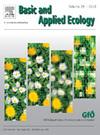Welcome for thee, but not for me: How demographic parameters and nature experience affect how close to home people accept animals
IF 3.5
2区 环境科学与生态学
Q2 ECOLOGY
引用次数: 0
Abstract
Animals are a constant presence in urban environments. While there is a handful of studies that have addressed which urban animals people like, there is little knowledge on where in cities people accept animals in relation to their homes. A preceding study by the authors indicated that Munich residents’ preferred proximity to animals is influenced by their attitudes towards these animals. Here, we go a step further and analyse how human demographic parameters and experience with animals influence people’s decision on where to place animals.
We used data on demographics, experiences, and attitudes to test how these factors influence how close to their home people accepted different animals – in the form of the closest relational scale chosen for the animals. A multigroup structural equation model with attitudes towards the animals as a mediator and the animals as grouping variables was used to disentangle the effects of different variables for placement, and to compare different animals. Variable selection and path constraint were done using PiecewiseSEM, and final estimates were produced with Lavaan.
We found that different demographics and experiences are associated with accepting animals closer to home or further away. People who liked animals more, had higher levels of education, stated that they enjoy spending time in nature more, or help animals in their environment, generally accepted most animals closer to their home. In contrast, people who live in a house instead of an apartment generally wanted most animals further away from home.
Our results emphasise that people have a differentiated view of animals that is influenced by both internal and external factors. Taking this into account can help identify reasons for the acceptance or rejection of an animal in urban environments, help guide urban conservation projects, and mediate human-wildlife conflicts.
欢迎你,但不欢迎我:人口统计参数和自然体验如何影响人们对动物的接受程度
动物是城市环境中不可缺少的存在。虽然有一些研究已经解决了人们喜欢哪些城市动物的问题,但关于城市中人们接受动物与他们的家园关系的研究却很少。作者之前的一项研究表明,慕尼黑居民对动物的偏好受到他们对动物的态度的影响。在这里,我们进一步分析了人类的人口统计参数和与动物的经验如何影响人们对动物安置地点的决定。我们使用人口统计、经验和态度的数据来测试这些因素如何影响人们对不同动物的接受程度——以为动物选择的最亲密关系量表的形式。采用多群体结构方程模型,以对动物的态度为中介,以动物为分组变量,理清不同变量对放置的影响,并对不同动物进行比较。使用PiecewiseSEM完成变量选择和路径约束,并使用Lavaan生成最终估计。我们发现,不同的人口统计和经历与接受离家近或离家远的动物有关。那些更喜欢动物的人,受教育程度更高,表示他们更喜欢花时间在大自然中,或者在他们的环境中帮助动物,通常接受大多数离他们家更近的动物。相比之下,住在房子里而不是公寓里的人通常希望大多数动物离家更远。我们的研究结果强调,受内部和外部因素的影响,人们对动物有不同的看法。考虑到这一点可以帮助确定在城市环境中接受或拒绝动物的原因,帮助指导城市保护项目,并调解人类与野生动物的冲突。
本文章由计算机程序翻译,如有差异,请以英文原文为准。
求助全文
约1分钟内获得全文
求助全文
来源期刊

Basic and Applied Ecology
环境科学-生态学
CiteScore
6.90
自引率
5.30%
发文量
103
审稿时长
10.6 weeks
期刊介绍:
Basic and Applied Ecology provides a forum in which significant advances and ideas can be rapidly communicated to a wide audience. Basic and Applied Ecology publishes original contributions, perspectives and reviews from all areas of basic and applied ecology. Ecologists from all countries are invited to publish ecological research of international interest in its pages. There is no bias with regard to taxon or geographical area.
 求助内容:
求助内容: 应助结果提醒方式:
应助结果提醒方式:


